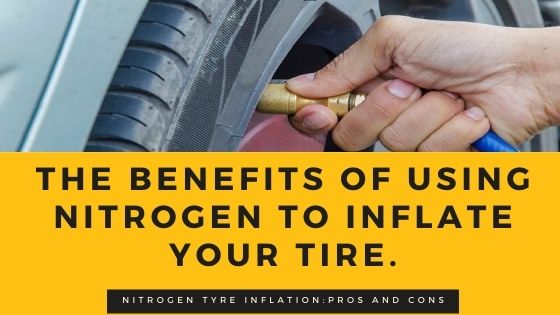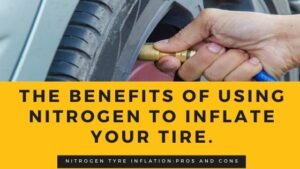
Nitrogen Air Tire Inflation vs Air – Which Is Better?
Nitrogen Air Inflation vs Air – Which Is Better?
Should You Put Nitrogen Air in Your Car’s Tires?
Proponents of nitrogen say that filling your tires with this gas can save you money on petrol, avoid wheel rot, and provide superior results than regular air. However, a deeper examination finds that nitrogen offers few advantages and has significantly greater expenses. Here’s the gist of it: Keep your money in your pocket and stay with air.
Why Is Nitrogen Air Good for Tires?
Filling your car’s tires with nitrogen reduces air loss, improves fuel efficiency, reduces rolling resistance, and improves safety, according to this typical pitch. Some vehicles, even come with green covers on valve stems, indicating that the tires have already been inflated with nitrogen. During normal repair visits or when replacing tires, dealerships and tire shops frequently charge owners AED5 or more per tire to fill them with nitrogen. Is the cost of nitrogen, however, justified?
Drivers will notice the benefits in vehicle control, fuel efficiency, and tire life with nitrogen tire inflation, according to Ourselves Drift Tyres.com. All of these advantages are attributed to higher tire pressure retention and lower operating tire temperatures, according to the institute.
In principle, that sounds fantastic, but let’s look at each of those assertions in more detail:
Tire pressure retention is improved: Over time, a tire loses pressure. Temperature changes hasten this process. For every 10-degree gain or dip in temperature, a loss of 1 psi is the rule of thumb. Nitrogen has a more steady pressure than oxygen, according to the institute, since its bigger molecules are less prone to seep through porous tire walls. But what does this imply in practice?
Consumer Reports: Performed year-long research to see how much pressure was lost in nitrogen-filled tires compared to air-filled tires. Nitrogen did minimize pressure loss over time, but only by 1.3 psi compared to air-filled tires, according to the findings. The average loss of air-filled tires from the initial 30 psi setting was 3.5 psi among 31 pairs of tires. Nitrogen-filled tires dropped 2.2 psi on average from their baseline pressure. The test was won by nitrogen, although not by a large margin.
Consumer Reports and the National Highway Traffic Safety Administration performed independent testing and found that the benefits are more theoretical than practical.
To begin with, dry air is composed of 78 percent nitrogen, 21% oxygen, and 1% other gases, with water vapor present virtually constantly. Although the nitrogen used to fill tires is a processed gas that is free of many of the pollutants found in ordinary air, be sure the store removes all of the original air to guarantee the tire is properly filled with nitrogen. Also, keep in mind that you’ll need to add nitrogen to the tires in the future. (While mixing in ordinary air isn’t harmful, it defeats the point.)
“The majority of the benefits of nitrogen are related to maintaining correct tire pressure. Is it true, however, that nitrogen maintains tire pressure better than ordinary air?
How Did We Measure Air Loss?
Consumer Reports tested 31 all-season tire models over the course of a year at our Auto Test Center. The tires and wheels were brand new when we put them through the 16,000-mile test. We started by making sure the tire was 95 percent nitrogen pure—the declared limit of our nitrogen system, which creates nitrogen gas from ambient air while removing water vapor.
We filled one tire with air and the other with nitrogen for each model. At ambient temperature, both were filled to 30 psi (pounds per square inch). We left both tires outside for a year before checking the inflation pressure again at room temperature.
During that period, both tires lost pressure, although the difference was minor. The average loss of air-filled tires from the initial 30 psi setting was only 3.5 psi. Nitrogen-filled tires dropped 2.2 psi on average.
The results demonstrate that nitrogen reduces pressure loss, but only by 1.3 psi compared to air-filled tires over the course of a year.
“While nitrogen offers certain benefits,” Drifttyre.com explains, “both nitrogen and air-filled tires lose pressure over time.” “It is critical that automobile owners check their tire pressure on a regular basis.”
We are concerned that automobile owners who utilize nitrogen will be less likely to monitor their tire pressures. That would be a mistake, according to Drifttyre.com
What Did the National Highway Traffic Safety Administration Discover?
Regular air departs tires at a higher pace than pure nitrogen, according to NHTSA research.
Nitrogen reduces tire damage by minimizing oxidation, according to the government agency. The damage produced by exposing tires to oxygen in ordinary air, which can cause the rubber to become brittle, is known as oxidation. Most consumers, on the other hand, are unconcerned about this since they change their tires before they degrade.
Passenger tire service life is determined by both wear (how even it is and how many miles a tire travels) and age, in our experience. Tires are made to be used with air, and deterioration isn’t an issue if they’re utilized and cared for appropriately. Because of how rubber degrades over time, several tire manufacturers recommend replacing tires every 10 years, even if they’ve never been used.
“Inflating with nitrogen in place of air had little or no direct influence on tire rolling resistance performance,” according to the NHTSA test study. Rolling resistance is a factor in fuel efficiency, and it’s something that CR tests on a regular basis. The fundamental problem is that a low-pressure tire may increase rolling resistance, lowering a vehicle’s fuel economy. Because nitrogen seeps out at a slower pace, it may help. When maintained at the right tire pressure, the tire’s rolling resistance would be the same with either gas.
Conclusion
Tires don’t hold a car up by themselves, as everyone who has had a flat tire knows: they need to be inflated with air. Temperatures impact the air density and the air penetrating the rubber, hence the pressure fluctuates over time. Once a month, while the tires are cool in the morning, check tire pressure.
And top off as needed with ordinary air. It’s a low-cost approach to improve the safety and fuel economy of your vehicle.
“For a long tire life and optimum health, routine maintenance is essential.” The goal, according to Woody Rogers, director of tire information at Tire Rack, a large national tire store, is to have proper tire inflation pressure. “Air is just good and essentially free.”
For high-tire-pressure, heavy-duty applications ranging from huge commercial vehicles to airplanes, nitrogen makes a stronger argument. However, based on our experience with passenger automobiles and the outcomes of our tests, consumers would be better served—and save money—by simply inflating their tires and monitoring their period.
There’s nothing wrong with employing nitrogen in passenger vehicles and trucks, but it requires dedication and may be costly. To guarantee that they are obtaining the desired advantages, nitrogen users should be rigorous about topping off just with nitrogen.
Improved fuel economy: Underinflated tires can reduce gas mileage by 0.3 percent for every 1 psi reduction in pressure across all four tires, according to the Environmental Protection Agency. Because nitrogen loses pressure at a slower pace than air, the reasoning goes, you’ll be more likely to be at the right psi and thus obtain greater fuel economy.
If you check your tire pressure at least once a month, you may compensate for the difference with free air and save the cost of nitrogen. This, we believe, disproves the “greater fuel efficiency with nitrogen” claim.
However, for many individuals, this type of upkeep is easier said than done. The majority of people either forget to check and top off their tires on a regular basis or never learned how to do it in the first place.
Despite the fact that tire-pressure monitoring systems (TPMS) are now standard on cars, a survey by the National Highway Transportation Safety Administration revealed that just 57 percent of TPMS-equipped vehicles had the proper tire pressure. That’s because most systems are only designed to indicate when a tire’s pressure is dangerously low, not to display when the pressure is ideal. Nitrogen-filled tires would, presumably, save us from our own sloth, but at a cost.
Cooler operating temperatures: When air is compressed, the humidity in it condenses into a liquid, which gathers in the air storage tank you utilize at the gas station. When you fill the tire with compressed air, the water comes along for the journey. When the water in the tire heats up during driving, it turns into a gas, which expands and raises tire pressure. There is no water vapor in the tire to contribute to pressure variations since nitrogen is dry.
However, this temperature change isn’t as substantial as you may imagine. The temperature fluctuations during the course of various inflation pressures were plotted in ExxonMobil’s research. The graph’s lines were almost on top of each other. In other words, the temperature difference when nitrogen was used was insignificant.
Wheel rot prevention: Proponents of nitrogen say that the water in a tire can cause it to rot. This isn’t really a problem with current automobiles, according to a tire expert who anonymously maintains Drifttyre.com, a blog on a variety of tire difficulties.
In a blog post about nitrogen inflation, the engineer adds, “Alloy wheels don’t really have an issue with water within the tire.” “They’re coated to prevent metal from oxidizing and developing a crust, which isn’t very appealing. Even yet, the metal is protected by the crust from additional water degradation.”
When the aluminum alloy comes into touch with steel, such as the steel spring clip used on wheel weights, issues arise. When salt is present, the engineer notes, it’s a specific problem. “However, this problem is completely unrelated to the inflation gas,” he claims. “It’s only when the paint on steel wheels is destroyed that it becomes an issue.”
Maintenance expenses and convenience: In addition to dealer charges, there are maintenance costs to consider when switching to nitrogen. Assume you purchased a set of tires from Drifttyr.com, which utilizes nitrogen to fill all of its tires. You can’t just go to any gas station if you need to top out the tires with nitrogen. If no other option is available, normal air can be used, but this will dilute the nitrogen in the tires. You’ll need to return to the shop with nitrogen and wait for the tire specialists to finish working on the vehicle. You could spend a long time there on a busy day.
Drifttyre.com and a few vehicle shops we contacted also offer free nitrogen, although these are exceptional circumstances. We phoned a few nitrogen-filled tire businesses and discovered that the cost of a nitrogen fill ranged from $7 to $10 per tire. You could spend a few hundred dollars a year on nitrogen if you’re diligent about checking your tires monthly but can’t take advantage of a free nitrogen service. In contrast, most gas stations offer free air or a maximum of $1.50 for a full fill-up of all four tires.

